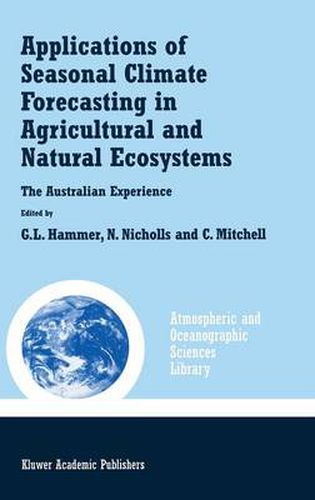Readings Newsletter
Become a Readings Member to make your shopping experience even easier.
Sign in or sign up for free!
You’re not far away from qualifying for FREE standard shipping within Australia
You’ve qualified for FREE standard shipping within Australia
The cart is loading…






This title is printed to order. This book may have been self-published. If so, we cannot guarantee the quality of the content. In the main most books will have gone through the editing process however some may not. We therefore suggest that you be aware of this before ordering this book. If in doubt check either the author or publisher’s details as we are unable to accept any returns unless they are faulty. Please contact us if you have any questions.
Climate variability has major impacts in many parts of the world, including Australia. Developments in understanding of the El Nino southern oscillation phenomenon have introduced some skill in seasonal to inter-annual climate forecasting. Can this skill be harnessed to advantage? Or do we just continue to observe these impacts? How does a decision-maker managing an agricultural or natural ecosystem modify decisions in response to a skilful, but imprecise, seasonal climate forecast? Using Australian experience as a basis, this book focuses on these questions in pursuing means to better manage climate risks. The state of the science in climate forecasting is reviewed before considering detailed examples of applications to: farm scale agricultural decisions (such as management of cropping and grazing systems); regional and national scale agricultural decisions (such as commodity trading and government policy); and natural systems (such as water resources, pests and diseases, and natural fauna). Many of the examples highlight the participatory and inter-disciplinary approach required among decision-makers, resource systems scientists/analysts, and climate scientists to bring about the effective applications. The experiences discussed provide insights beyond the geographical and disciplinary focus of this book. The text is designed to be suitable for professionals and postgraduate students in ecology, agricultural climatology, environmental planning, and climate science.
$9.00 standard shipping within Australia
FREE standard shipping within Australia for orders over $100.00
Express & International shipping calculated at checkout
This title is printed to order. This book may have been self-published. If so, we cannot guarantee the quality of the content. In the main most books will have gone through the editing process however some may not. We therefore suggest that you be aware of this before ordering this book. If in doubt check either the author or publisher’s details as we are unable to accept any returns unless they are faulty. Please contact us if you have any questions.
Climate variability has major impacts in many parts of the world, including Australia. Developments in understanding of the El Nino southern oscillation phenomenon have introduced some skill in seasonal to inter-annual climate forecasting. Can this skill be harnessed to advantage? Or do we just continue to observe these impacts? How does a decision-maker managing an agricultural or natural ecosystem modify decisions in response to a skilful, but imprecise, seasonal climate forecast? Using Australian experience as a basis, this book focuses on these questions in pursuing means to better manage climate risks. The state of the science in climate forecasting is reviewed before considering detailed examples of applications to: farm scale agricultural decisions (such as management of cropping and grazing systems); regional and national scale agricultural decisions (such as commodity trading and government policy); and natural systems (such as water resources, pests and diseases, and natural fauna). Many of the examples highlight the participatory and inter-disciplinary approach required among decision-makers, resource systems scientists/analysts, and climate scientists to bring about the effective applications. The experiences discussed provide insights beyond the geographical and disciplinary focus of this book. The text is designed to be suitable for professionals and postgraduate students in ecology, agricultural climatology, environmental planning, and climate science.